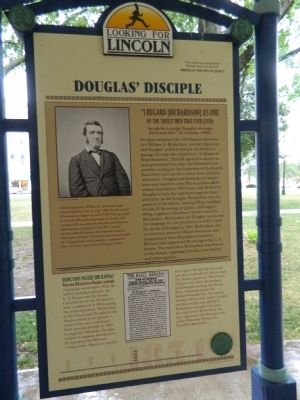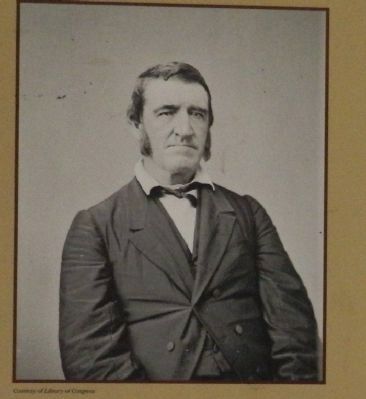Douglas' Disciple
Looking for Lincoln
"I regard (Richardson) as one of the truest men that ever lived; he 'sticks to judge Douglas through thick and thin" (A. Lincoln, 1860). Douglas composed the 1854 Kansas-Nebraska Act. William A. Richardson, another Quincyan and Douglas' political disciple, facilitated its passage through the turbulent U.S. House of Representatives. This bill opened to slavery an area guaranteed free since the Missouri Compromise, leading to the formation of the Republican Party and Lincoln's return from political retirement. Douglas and Richardson's names were interwoven in early Illinois politics. Richardson benefited in 1835 from a bill drafted by Douglas to have the legislature appoint states attorneys. As did Douglas, Richardson won the position in his district, beating Whig candidate Orville H. Browning of Quincy. Although a Whig, Legislator Abraham Lincoln voted for Richardson. Richardson led Douglas' unsuccessful campaign for the presidency in 1860. upon the death of Douglas in 1861, Richardson, the second most powerful Illinois Democrat, was disappointed when Republican Governor Richard Yates appointed Browning to the U.S. Senate. Two years later, Richardson was elected to the Senate, opposing Lincoln, conscription, and emancipation.
Political opponents William A. Richardson and Lincoln had close ties. In early 1860 Lincoln invited Richardson to sculptor Leonard Volk's Chicago studio to view the life mask being made of Lincoln. Volk recounted the two amused each other with pleasant reminiscences. During the Civil War, Lincoln recommended Richardson for Brigadier General. Richardson declined. Richardson scarcely warranted the "Copperhead" label sometimes attributed to him---he never wavered from being pro-Union.
Quincyans passed the Kansas Nebraska Bill based on Douglas' principle of popular sovereignty. With the nation moving westward, the U.S. House and the Senate Committees on the Territories were considered in 1854 among the most important. Richardson in the House and Douglas in the Senate---both from Quincy---chaired the two committees. Each introduced bills in 1853 to organize Nebraska. Douglas' written to appease Southerners by repealing the Missouri Compromise. Based on popular sovereignty, the bill allowed each new state to decide the slavery issue. The Senate approved. The House debated it for days. Richardson, with Douglas working the House floor, ultimately passed the Kansas-Nebraska Act. The Quincy Herald, a Democratic paper, praised the Bill and the role played by Richardson, strongly criticizing the opponents. Richardson was later appointed the first governor of the Nebraska Territory by President Buchanan.
Erected by
Topics and series. This historical marker is listed in these topic lists: Abolition & Underground RR • Government & Politics. In addition, it is included in the Former U.S. Presidents: #16 Abraham Lincoln, and the Looking for Lincoln series lists. A significant historical year for this entry is 1854.
Location. 39° 55.981′ N, 91° 24.544′ W. Marker is in Quincy, Illinois, in Adams County. Marker is on Hampshire Street. Marker is in Washington Square. Touch for map. Marker is at or near this postal address: 101 North 5th Street, Quincy IL 62301, United States of America. Touch for directions.
Other nearby markers. At least 8 other markers are within walking distance of this marker. Quincy's Judge Douglas (here, next to this marker); Downtown Quincy in 1858 (here, next to this marker); Lincoln's Quincy (here, next to this marker); Washington Theater (within shouting distance of this marker); Lincoln Correspondent (within shouting distance of this marker); Lincoln Promoter (within shouting distance of this marker); Spread of Slavery Into The Territories (within shouting distance of this marker); Dred Scott Decision (within shouting distance of this marker). Touch for a list and map of all markers in Quincy.
Also see . . . William Alexander Richardson. Biographical Directory of the United States Congress entry (Submitted on August 25, 2012, by Bill Pfingsten of Bel Air, Maryland.)
Credits. This page was last revised on January 3, 2021. It was originally submitted on August 25, 2012, by Bill Pfingsten of Bel Air, Maryland. This page has been viewed 777 times since then and 13 times this year. Photos: 1, 2. submitted on August 25, 2012, by Bill Pfingsten of Bel Air, Maryland.

